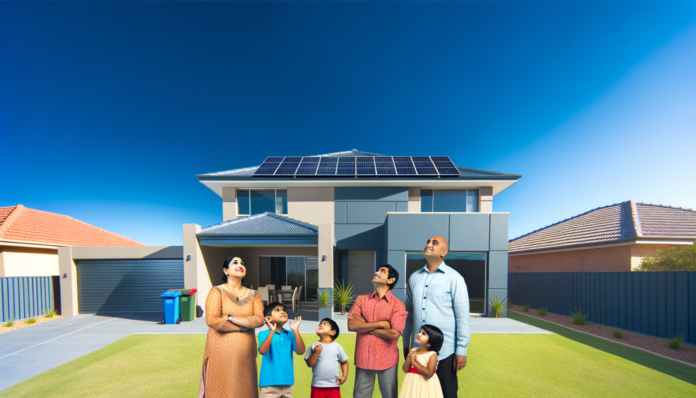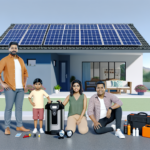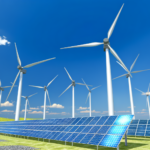Introduction to Solar Power Systems
What is Solar Power?
Solar power is the conversion of energy from sunlight into electricity, either directly using photovoltaics (PV), indirectly using concentrated solar power (CSP), or a combination of both. Photovoltaic systems use solar panels composed of numerous solar cells that convert sunlight into electricity. Concentrated solar power systems use mirrors or lenses to concentrate a large area of sunlight onto a small area, generating heat that can be used to produce electricity.
Why Consider Solar Power?
There are several compelling reasons to consider solar power:
- Environmental Impact: Solar power is a clean and renewable energy source that reduces greenhouse gas emissions and dependence on fossil fuels.
- Cost Savings: Over time, solar power can significantly reduce electricity bills. Many regions offer incentives, tax credits, and rebates to offset the initial installation costs.
- Energy Independence: Solar power provides a degree of energy independence, reducing reliance on the grid and protecting against rising energy costs.
- Technological Advancements: Advances in solar technology have made systems more efficient and affordable, increasing their accessibility to a broader range of consumers.
Overview of Solar Power Systems
Solar power systems come in various configurations, each designed to meet different energy needs and circumstances. Here is a brief overview of the main types:
- Grid-Tied Solar Systems: These systems are connected to the local utility grid, allowing homeowners to use solar power when available and draw from the grid when it is not. Excess energy can often be sold back to the utility company.
- Off-Grid Solar Systems: These systems are entirely independent of the utility grid and typically include battery storage to provide power when sunlight is not available. They are ideal for remote locations without access to the grid.
- Hybrid Solar Systems: Combining the features of grid-tied and off-grid systems, hybrid systems are connected to the grid but also include battery storage. This setup provides greater flexibility and reliability.
- Portable Solar Systems: These are small, mobile solar power units that can be used for camping, RVs, or emergency backup. They are easy to transport and set up, providing a convenient power source on the go.
In summary, solar power systems offer a versatile and sustainable solution for generating electricity. Whether you are looking to reduce your carbon footprint, save on energy costs, or gain energy independence, there is a solar power system to meet your needs.
Types of Solar Power Systems
Grid-Tied Solar Systems
Grid-tied solar systems are the most common type of solar power system. These systems are connected to the local electrical utility grid, allowing homeowners to draw electricity from both their solar panels and the grid. During the day, when the solar panels generate more electricity than needed, the excess power is fed back into the grid, often earning the homeowner credits through net metering. At night or during cloudy days, when the solar panels are not producing enough electricity, the home can draw power from the grid.
**Advantages:**
– **Cost Savings:** Homeowners can significantly reduce their electricity bills by offsetting their power consumption with solar energy.
– **Reliability:** Access to the grid ensures a continuous power supply, even when solar production is low.
– **Net Metering:** Excess energy can be sold back to the grid, providing additional financial benefits.
**Considerations:**
– **Power Outages:** Grid-tied systems do not provide power during a grid outage unless paired with a battery backup.
– **Regulations:** Homeowners must comply with local utility regulations and may need to obtain permits.
Off-Grid Solar Systems
Off-grid solar systems are designed for complete independence from the local utility grid. These systems are ideal for remote areas where grid access is unavailable or unreliable. Off-grid systems typically include solar panels, a charge controller, a battery bank, and an inverter to store and convert solar energy for use.
**Advantages:**
– **Energy Independence:** Complete autonomy from the utility grid.
– **Remote Locations:** Ideal for areas without grid access.
– **Sustainability:** Reduces reliance on fossil fuels and promotes renewable energy use.
**Considerations:**
– **Initial Cost:** Higher upfront costs due to the need for batteries and other components.
– **Maintenance:** Requires regular maintenance and monitoring of battery health.
– **Energy Management:** Users must carefully manage energy consumption to avoid running out of power.
Hybrid Solar Systems
Hybrid solar systems combine the benefits of both grid-tied and off-grid systems. These systems are connected to the grid but also include a battery backup to store excess solar energy. During a power outage, the battery can provide electricity, ensuring a continuous power supply.
**Advantages:**
– **Reliability:** Provides power during grid outages.
– **Energy Management:** Stores excess energy for later use, reducing reliance on the grid.
– **Flexibility:** Can switch between solar, battery, and grid power as needed.
**Considerations:**
– **Cost:** Higher initial investment due to the inclusion of batteries.
– **Complexity:** More complex installation and maintenance compared to grid-tied systems.
– **Regulations:** Must comply with local utility and grid interconnection regulations.
Portable Solar Systems
Portable solar systems are designed for mobility and ease of use. These systems are ideal for camping, outdoor activities, and emergency backup power. Portable solar systems typically include compact solar panels, a charge controller, and a battery pack.
**Advantages:**
– **Mobility:** Easy to transport and set up.
– **Versatility:** Can be used in various locations and situations.
– **Emergency Use:** Provides backup power during emergencies.
**Considerations:**
– **Power Output:** Limited power output compared to permanent installations.
– **Battery Life:** Dependent on battery capacity and usage.
– **Durability:** May be less durable than fixed solar installations.
In summary, the choice of a solar power system depends on individual needs, location, and budget. Grid-tied systems offer cost savings and reliability, off-grid systems provide complete energy independence, hybrid systems ensure continuous power supply, and portable systems offer flexibility and mobility. Understanding the advantages and considerations of each type can help homeowners make an informed decision about which solar power system is best for them.
Components of Solar Power Systems
Solar power systems are composed of several key components that work together to convert sunlight into usable electricity. Understanding these components is essential for anyone considering a solar power system for their home or business. Below, we break down the main components: solar panels, inverters, batteries, charge controllers, and mounting systems.
Solar Panels
Solar panels are the heart of any solar power system. They convert sunlight into electricity through the photovoltaic effect. Each panel is made up of multiple solar cells, typically silicon-based, which are wired together and encased in a protective frame. There are two main types of solar panels:
- Monocrystalline Panels: Made from a single, pure crystal of silicon, these panels are highly efficient and have a sleek, black appearance.
- Polycrystalline Panels: Made from multiple silicon crystals, these panels are less efficient but more cost-effective, and they have a distinctive blue hue.
Solar panels come in various sizes, commonly 60-cell or 72-cell configurations, and their efficiency can vary based on the quality of the cells and the manufacturing process.
Inverters
Inverters are crucial for converting the direct current (DC) electricity generated by solar panels into alternating current (AC) electricity, which is used by most household appliances. There are several types of inverters:
- String Inverters: These are cost-effective and suitable for installations with minimal shading. They connect multiple panels in a series.
- Microinverters: Attached to each panel, these inverters optimize the output of individual panels and are ideal for installations with shading issues.
- Power Optimizers: These devices work with string inverters to optimize the performance of each panel, mitigating the effects of shading.
- Storage-Ready Inverters: These inverters are designed to work with battery storage systems, allowing for energy storage and use during non-sunny periods.
Batteries
Batteries store excess electricity generated by solar panels for use when sunlight is not available. They are essential for off-grid systems and useful for grid-tied systems with backup needs. Types of batteries include:
- Flooded Lead-Acid Batteries: Cost-effective but require regular maintenance.
- Sealed Lead-Acid Batteries: Maintenance-free and safer, available in AGM and gel variants.
- Lithium Batteries: More expensive but offer longer life, higher efficiency, and are maintenance-free.
Charge Controllers
Charge controllers regulate the flow of electricity from the solar panels to the batteries, preventing overcharging and ensuring optimal battery performance. There are two main types:
- Pulse Width Modulation (PWM) Controllers: These are simpler and less expensive, suitable for smaller systems.
- Maximum Power Point Tracking (MPPT) Controllers: These are more efficient and can handle larger systems, optimizing the power output from the panels.
Mounting Systems
Mounting systems secure solar panels in place, either on rooftops or the ground. The choice of mounting system depends on the installation site and specific needs:
- Roof Mounts: These are the most common and cost-effective, utilizing the existing structure of the roof.
- Ground Mounts: These offer flexibility in panel orientation and are easier to access for maintenance but require more space and a stable foundation.
- Pole Mounts: Ideal for snowy or hilly areas, these mounts elevate panels on poles, allowing for adjustable angles and better snow shedding.
- Ballasted Mounts: These are used for flat roofs or ground installations where drilling is not feasible, relying on weight to hold the panels in place.
Understanding these components and their functions is crucial for designing an efficient and effective solar power system tailored to your specific needs.
Choosing the Right Solar Power System
Assessing Your Energy Needs
Before diving into the world of solar power, it’s crucial to understand your household’s energy consumption. Start by reviewing your electricity bills over the past year to identify your average monthly usage in kilowatt-hours (kWh). This will give you a baseline for the size of the solar power system you need. Additionally, consider any future changes that might affect your energy needs, such as purchasing an electric vehicle or adding new appliances. By accurately assessing your energy requirements, you can ensure that your solar power system is appropriately sized to meet your needs.
Evaluating Your Location
The efficiency of a solar power system is heavily influenced by your geographical location and the specific characteristics of your property. Factors such as the amount of sunlight your area receives, the orientation and angle of your roof, and potential shading from trees or buildings all play a role. Use tools like solar maps or consult with a professional to evaluate the solar potential of your location. In regions with less sunlight, you may need a larger system to generate the same amount of power as a smaller system in sunnier areas. Proper evaluation ensures that you maximize the efficiency and output of your solar power system.
Budget Considerations
Budget is a significant factor when choosing a solar power system. The initial cost of solar panels, inverters, batteries, and installation can be substantial. However, various financing options are available, including loans, leases, and power purchase agreements (PPAs). Additionally, federal and state incentives, such as the 30% federal tax credit, can significantly reduce the upfront cost. When planning your budget, consider not only the initial investment but also the long-term savings on your electricity bills. A well-planned budget will help you make an informed decision that balances cost and benefits.
Future Expansion and Scalability
When selecting a solar power system, it’s wise to consider future expansion and scalability. Your energy needs may increase over time, and having a system that can be easily expanded will save you from costly upgrades. Look for systems that allow for additional panels or battery storage to be added without significant modifications. This flexibility ensures that your solar power system can grow with your household’s energy demands, providing a sustainable and long-term solution.
By carefully assessing your energy needs, evaluating your location, considering your budget, and planning for future expansion, you can choose the right solar power system that meets your current and future energy requirements.
Installation and Maintenance
DIY vs. Professional Installation
When it comes to installing solar power systems, homeowners have two primary options: **DIY installation** or **professional installation**. Each approach has its own set of advantages and considerations.
**DIY Installation**:
– **Cost Savings**: One of the most significant benefits of DIY installation is the potential for cost savings. By eliminating labor costs, homeowners can reduce the overall expense of their solar power system.
– **Learning Experience**: For those who enjoy hands-on projects, installing a solar power system can be a rewarding learning experience.
– **Flexibility**: DIY installation allows homeowners to work at their own pace and schedule.
However, DIY installation also comes with challenges:
– **Complexity**: Installing a solar power system involves electrical work, roof mounting, and system configuration, which can be complex and time-consuming.
– **Permits and Regulations**: Navigating local permits and regulations can be daunting for those unfamiliar with the process.
– **Warranty and Support**: DIY installations may not be covered by warranties, and homeowners may have limited access to technical support.
**Professional Installation**:
– **Expertise**: Professional installers have the experience and knowledge to ensure that the system is installed correctly and efficiently.
– **Permits and Paperwork**: Professionals handle the necessary permits and paperwork, streamlining the process for homeowners.
– **Warranty and Maintenance**: Many professional installations come with warranties and maintenance plans, providing peace of mind and long-term support.
While professional installation may come at a higher cost, the benefits of expertise, convenience, and support often outweigh the expense for many homeowners.
Maintenance Tips
Maintaining a solar power system is crucial for ensuring its longevity and efficiency. Here are some essential maintenance tips:
– **Regular Cleaning**: Dust, dirt, and debris can accumulate on solar panels, reducing their efficiency. Clean the panels with water and a soft brush or sponge every few months, or more frequently in dusty areas.
– **Inspect for Damage**: Regularly inspect the panels, inverters, and wiring for any signs of damage or wear. Look for cracks, corrosion, or loose connections.
– **Monitor Performance**: Use a monitoring system to track the performance of your solar power system. Sudden drops in energy production can indicate issues that need attention.
– **Trim Nearby Trees**: Ensure that trees and other vegetation do not cast shadows on the panels, as shading can significantly reduce energy output.
– **Check Inverter Status**: The inverter is a critical component of the system. Regularly check its display for error messages or warnings and address any issues promptly.
By following these maintenance tips, homeowners can maximize the efficiency and lifespan of their solar power systems.
Troubleshooting Common Issues
Even with regular maintenance, solar power systems can encounter issues. Here are some common problems and troubleshooting steps:
– **Low Energy Production**: If your system is producing less energy than expected, check for shading, dirty panels, or inverter issues. Clean the panels, trim any overhanging branches, and ensure the inverter is functioning correctly.
– **Inverter Errors**: Inverter error messages can indicate various issues, from wiring problems to component failures. Refer to the inverter’s manual for specific error codes and troubleshooting steps. If the issue persists, contact a professional.
– **System Shutdowns**: Unexpected system shutdowns can be caused by grid issues, faulty wiring, or component failures. Check the breaker box and wiring connections. If the problem continues, seek professional assistance.
– **Battery Issues**: For systems with battery storage, monitor the battery’s charge and discharge cycles. If the battery is not holding a charge, it may need to be replaced or serviced.
By addressing these common issues promptly, homeowners can ensure their solar power systems continue to operate efficiently and reliably.
Benefits of Solar Power Systems
Environmental Impact
Solar power systems offer significant environmental benefits by reducing our reliance on fossil fuels, which are major contributors to climate change and air pollution. Unlike traditional energy sources, solar power generates electricity without emitting greenhouse gases or other harmful pollutants. This helps to mitigate global warming and improve air quality, leading to better health outcomes for communities. Additionally, solar power systems do not require water for cooling or steam generation, conserving valuable water resources, especially in arid regions.
Cost Savings
One of the most compelling benefits of solar power systems is the potential for substantial cost savings. By generating their own electricity, homeowners and businesses can significantly reduce their monthly utility bills. The initial investment in solar panels and installation can be offset by long-term savings, often allowing the system to pay for itself within six to ten years. Furthermore, many regions offer incentives, tax credits, and net metering programs that can further reduce the financial burden and enhance the return on investment. Over time, as electricity prices continue to rise, the cost savings from solar power will become even more pronounced.
Energy Independence
Solar power systems provide a pathway to energy independence by allowing individuals and businesses to generate their own electricity. This is particularly beneficial in remote or off-grid areas where access to the traditional power grid is limited or unreliable. With the addition of battery storage systems, solar power can ensure a continuous supply of electricity even during nighttime or cloudy days. This independence not only enhances energy security but also provides a reliable backup during power outages, making solar power a resilient and dependable energy solution.
Technological Advancements
The solar power industry has seen remarkable technological advancements over the past few decades, making solar systems more efficient, affordable, and accessible. Innovations in photovoltaic cell technology, such as the development of monocrystalline and polycrystalline panels, have significantly improved energy conversion rates. Additionally, advancements in battery storage, like lithium-ion and flow batteries, have addressed the issue of energy storage, making solar power a more viable option for continuous energy supply. As technology continues to evolve, the efficiency and cost-effectiveness of solar power systems are expected to improve further, making them an increasingly attractive option for a broader range of applications.
In summary, the benefits of solar power systems are multifaceted, encompassing environmental, economic, and technological advantages. By investing in solar power, individuals and businesses can contribute to a more sustainable future while enjoying significant cost savings and energy independence.
Conclusion
Recap of Key Points
As we have explored throughout this article, solar power systems offer a diverse range of options to meet various energy needs and preferences. From grid-tied systems that integrate seamlessly with existing utility grids to off-grid systems that provide complete energy independence, there is a solar solution for every situation. Hybrid systems combine the best of both worlds, offering reliability and flexibility, while portable solar systems provide energy on the go. Each type of system has its unique components, including solar panels, inverters, batteries, charge controllers, and mounting systems, all of which play crucial roles in the efficient conversion and storage of solar energy.
Choosing the right solar power system involves assessing your energy needs, evaluating your location, considering your budget, and planning for future expansion. Installation and maintenance are also critical factors, with options ranging from DIY setups to professional installations. Regular maintenance and troubleshooting can ensure the longevity and efficiency of your solar power system.
The benefits of adopting solar power are manifold, including significant environmental impact, cost savings, energy independence, and the advantage of technological advancements. Solar power not only reduces carbon footprints but also offers a sustainable and economically viable energy solution for the future.
Encouragement to Explore Solar Options
The transition to solar power is not just a trend; it is a movement towards a more sustainable and self-sufficient future. Whether you are a homeowner looking to reduce your electricity bills, a business aiming to enhance corporate sustainability, or an individual seeking energy independence, solar power offers a viable and rewarding solution. The advancements in solar technology have made it more accessible and affordable than ever before. By exploring your solar options, you are taking a significant step towards contributing to a cleaner environment and a more resilient energy infrastructure.
Investing in solar power is an investment in the future. It is an opportunity to harness the abundant energy of the sun, reduce reliance on fossil fuels, and mitigate the impacts of climate change. The journey to solar energy may come with its challenges, but the long-term benefits far outweigh the initial hurdles. Embrace the potential of solar power and join the growing community of individuals and organizations committed to a sustainable future.
Additional Resources
To further assist you in your journey towards adopting solar power, here are some valuable resources:
- Solar Energy Industries Association (SEIA): www.seia.org – A comprehensive resource for information on solar energy policies, market trends, and industry news.
- National Renewable Energy Laboratory (NREL): www.nrel.gov – Offers extensive research and data on renewable energy technologies, including solar power.
- EnergySage: www.energysage.com – A platform that provides comparisons of solar quotes, financing options, and installer reviews.
- U.S. Department of Energy – Solar Energy Technologies Office: www.energy.gov/eere/solar/solar-energy-technologies-office – Provides information on federal initiatives, research, and development in solar energy.
- Local Solar Installers: Reach out to local solar installation companies for personalized consultations and quotes tailored to your specific needs and location.
By leveraging these resources, you can gain a deeper understanding of solar power systems, stay updated on the latest advancements, and make informed decisions about your solar energy investments. The future of energy is bright with solar power, and now is the perfect time to explore your options and take the first step towards a sustainable and energy-efficient future.






